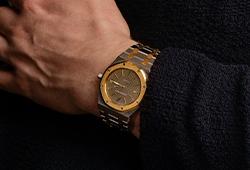Rolf Hanson
"Runtom trappa"
Signed Rolf Hanson and dated 2008 verso. Oil on panel 140 x 130 cm.
Alkuperä - Provenienssi
Galleri Örsta, Kumla.
Private Collection.
Muut tiedot
Rolf Hanson's painting oscillates between the abstract and the figurative as well as between surface and depth. He has formed his unique and personal expression, filled with energy and rhythm, from these contradictions. Regardless of whether he is working on a series of e.g. stairs and houses or letting the color play freely in abstract compositions, the tension between the spatial and the flat image surface of the canvas is ever-present. However, color always has a central place in his art and gives the paintings a harmony of their own. In an interview in connection with the exhibition at Pumphusets Konsthall in Landskrona, Hanson likened his creation to music: " - It is much like a composer who writes a piece of music, it's about achieving balance. Composition is one thing, the color palette is another. It's about combining them".
During his career, Rolf Hanson has tackled various series of motifs, but the series that is considered central and most praised is "Runtom trappa", which was also his big breakthrough. In 1999 he was awarded first prize in the prestigious Carnegie Art Award for Runtom trappor IV, V and VI and then described the origin of the series: - "During a stay in Grez-sur-Loing, France I decided to walk to Montigny-sur-Loing and see a famous staircase that is there. I then the subject matter so interesting reality that I wanted to set about the task of trying to make a painting of it to take home to Sweden, as a memory from my stay in France.
- It is the same staircase as in Carl Fredrik Hill's painting from 1876. How has he influenced you?
- Influenced? I think he is a very good painter! It was inspiring to use the same motif as Hill and then make my own version of the stairs.
- The colors red and yellow in contrast with dark areas are constantly recurring in your paintings. Do these colors mean something special to you?
- No color is more important than the other. I try to relate to the colors as freely as possible in order to explore them as far as possible".
The auction's painting is an impressive example of Rolf Hanson's ability to let the image surface remain open and closed simultaneously. The staircase rises upwards and invites the viewer's gaze to wander into the image, resulting in an almost dizzying experience. The color seems to flow down the steps while the balance is maintained by the play between light and shadow. Hanson has described the staircase in the following words: "A staircase is such a common feature of the private and public architecture we move around on a daily basis that we hardly notice it - provided, of course, that we move without difficulty and the stairs, therefore, do not constitute an obstacle. Seen with a painter's eye, the staircase becomes a challenge of a different kind: its smooth transition between vertical and horizontal planes and its perspectival qualities make the staircase as interesting as it is a difficult object to depict, both in terms of the play of light and lines".

















































